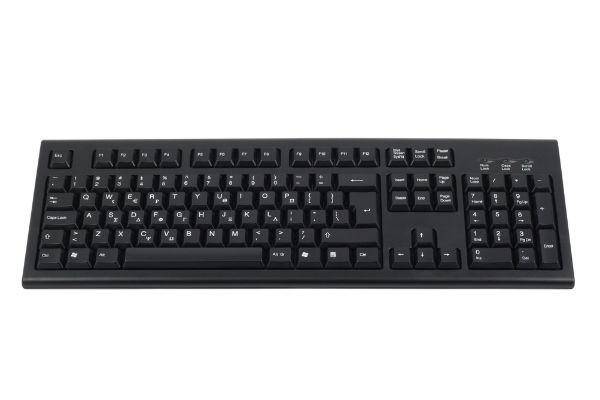Disclaimer: This post may contain affiliate links, meaning we get a small commission if you make a purchase through our links, at no cost to you. For more information, please visit our Disclaimer Page.
It’s safe to say that a keyboard is one of the main peripherals peaople use with their computers. Along with the mouse and monitor, practically any standard representation that comes to mind when we think of a computer will include a keyboard.
Because keyboards are primary access points that we constantly touch when we need to work with our computers, they can accumulate grime over time. The small recesses behind the settings for each key are prime spots for building up dust and retaining debris.
Our article will focus on how you might be able to use water to clean your keyboard, and what steps you can take to do a thorough job.
Table of Contents
Can I Wash My Keyboard With Water?
The short answer is yes; you can wash or clean your keyboard with water. However, as with many things in the tech world, it isn’t so simple that we can just leave it at that. It should be safe and handy to wash a keyboard with water if you follow some specific, recommended steps and don’t try to use water where you shouldn’t.
Water has been a great cleaner for many things throughout human history. However, electronics and water typically do not get gotten along well together. Like most things in a computer, the keyboard contains some sensitive electronic components.
We need to ensure that none of these gets wet or builds up any excess moisture. Water can wreak havoc on these devices and cause them to stop functioning. If you are careful, you can clean different parts of your keyboard with water and reassemble it in good working order.
Can You Put Keyboard Keys in Soapy Water?
Some people prefer to use a small amount of washing liquid and a brush or other fine tools to clean the keys. While others like to put the keys from their keyboards into a bowl of soapy water. It should be fine to do this if you disassemble the keycaps from the rest of the keyboard before you dunk them.
This way, you should be able to clean the entire surface of each key inside and out. Typically, it is easier to do this with a mechanical keyboard, but the same principles also will apply to one that is not mechanical.
1. Before you begin, we recommend taking a photo of your keyboard as it is. This will help you remember where all the keys go. Even if you’ve used your keyboard for years, this is a good step to take.
2. Fill an appropriately sized container with water. Add a small amount of dish soap to the container and swish it around.
3. You may wish to swish or move the keys around gently but continuously for the first 10 minutes or so. Doing this can help all of the angles get some of the cleaning solution onto them.
4. However you start washing them, leave the keys in soapy water for about an hour total. Try to plan your keyboard cleaning so that you at least have enough time to let them have a good soak for 45 minutes.
5. Once the soaking process is complete, use a clean rag or soft brush to give each key extra care in removing grime.
6. Now the cleaning process is complete, set the keys out and let them dry completely in the air. It is very important that keys have a chance to dry fully before you reinstall them in a keyboard, so make sure you allow enough time for this.
7. Not letting keys dry completely could cause later problems with the keyboard. However, as long as you follow the steps, this is a great method for cleaning keys.
8. Once the keys are dry, use the picture you took beforehand to reassemble them in their appropriate spots on the keyboard’s frame.
Can I Put My Keyboard in the Dishwasher?
Technically, yes, you can put your keyboard in the dishwasher to clean it. However, there are a few major caveats that you should keep in mind before you decide to combine these two things. You may have read stories of people putting their keyboards through a dishwasher and experiencing no issues. While this may be true, it is probably because they only put certain parts of a keyboard into the dishwasher, and then used very specific settings during the wash cycle.
As we’ve discussed, water and electronic components have a tumultuous history, and it is best that they don’t meet.
In most cases, you will need to disassemble the computer keyboard partially to ensure that only certain parts of it are cleaned in the dishwasher. Key switches on most mechanical keyboards are unsealed.
This means that any water that gets into the switches could corrode the springs and other things that make a mechanical board function so well.
You also should not include detergent as a cleaning agent when washing the keyboard.
When we talk about water being bad for electronics, what we really mean is that water can cause things to short out if there is excess moisture in places where it shouldn’t be when you turn a device on. In short, it is possible to use a dishwasher to clean certain types of keyboards precisely because they are off when you are cleaning them.
However, be aware that it will take several days of air drying to make sure that a keyboard washed this way is dried out completely and ready to be powered up. Make sure you have a spare keyboard to use in the meantime.
Can You Rinse a Laptop Keyboard?
For our purposes, we’ll define “rinsing” here as wiping down parts of a keyboard with water or other liquids rather than submerging it in any kind of stream.
However, if the keyboard isn’t allowed to dry completely, you could find yourself with a problem on your hands when you try to start it up again. Rinsing a keyboard in any kind of stream could compound the issue, even if it is possible that you could do this effectively.
Laptop keyboards come with certain other restrictions. They are a part of the frame of the unit, and it would be difficult to rinse them effectively in a more traditional manner. Although you can take the laptop apart in some ways, this is a delicate process that could be more trouble than it is worth if your aim is simply to clean the keyboard.
If there is a significant buildup of grime under the keys that you can’t get out through other methods, it is possible that some kind of partial disassembly might be necessary.
For a laptop keyboard, there are a couple of main things you can do to ensure that you clean if effectively and reduce the risk of harm to the components:
1. Dampen a clean microfiber cloth with some water or rubbing alcohol that you can pass over the keys gently.
2. Although a damp cloth or wipe is fine, avoid those that are soaked in bleach. Additionally, you don’t want to work with a soaked cloth for this job.
3. You can take the keys off for a more thorough cleaning. However, be aware that this is only advisable for some laptop models, not all of them. Check the make and model of your device to ensure that trying to get the keys off is okay.
4. You can use a small cotton swab to get into crevices and remove grime that is in difficult places.
5. Regardless of the methods that you choose, make sure you allow the keyboard to dry fully before you turn the laptop on again.
What Is the Best Way To Clean a Keyboard?
As you can see, there are multiple ways to use liquids to clean keyboards on both desktop computers and laptops.
As long as you keep some important things in mind, you should be able to clean the keyboards safely and without risk. However, there are a couple of other things that you can add to your keyboard cleaning routine.
1. You can turn the keyboard over to shake out any loose debris prior to the full cleaning process. This can eliminate larger particles of things before they get trapped somewhere.
2. Compressed air can help to remove more stubborn things from the keyboard before you wash or wipe it down.
You can get a can with a thin nozzle attached to it. However, don’t insert the nozzle underneath the keyboard keys when doing this.
3. After you’ve wiped things down or washed them using the methods we’ve discussed above, you can use a small vacuum cleaner to suck up any remaining debris on the surface of the keyboard.
Conclusion
Anyone who uses a desktop or laptop is going to touch the keyboard several times a day. It can leave noticeable gunk on or under the keys, and plenty of invisible germs can find homes there as well.
While you don’t need to do any kind of deep cleaning for your keyboard every day, knowing some of the best methods to do so safely will be a big help. Take a good look at the keyboard every few months to see if there is any noticeable buildup of dirt and dust that you could wipe away.


